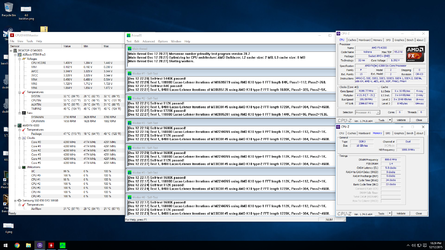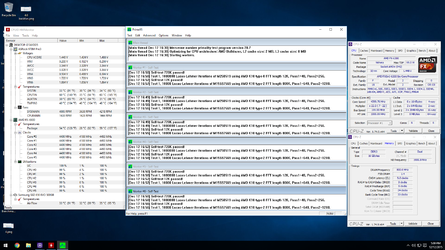- Joined
- Dec 12, 2015
- Location
- North Carolina, USA
Hello all,
I just recently finished setting up my new gaming rig, as well as a first round of overclocking to get the most out of my build. Here are my specs:
CPU: AMD FX-6300
Motherboard: Asrock 970M Pro3 (newer revision with heatsinks on the VRMs)
Cooler: Corsair H55 refurb. w/ Arctic Silver 5 grease
Case: DIYPC P48-BK micro-atx mid tower
GPU: EVGA GTX 960 SSC ACX
RAM: 2x8GB DDR3 Mushkin ECO2 1600 9-9-9-24 @1.35V
PSU: EVGA 600B (600W)
SSD: Samsung 850 EVO 500GB
DVD writer: Samsung SH-224FB/RSBS SATA
OS: Windows 10 Home
My best results so far have been 4.4GHz @1.525 V (any lower and it fails Prime95), but since I'm not sure I am comfortable with voltages like that in a 24/7 machine, I currently have it at 4.2GHz @1.475V-- and even that is kinda marginal for me.
BIOS settings:
Spread Spectrum - disabled
Turbo boost - disabled
APM - disabled
Cool 'n' quiet - disabled
C1E state - disabled
SVM - enabled
Core C6 mode - disabled
Thermal Throttle - auto
In addition to the liquid cooler, I have a fan at the back of the motherboard to keep the socket temp down as well as another fan blowing down onto the VRMs and northbridge (stuck to the CPU block and radiator with Velcro). My temps are fine, but I have been having real issues with stability, even before I put the extra fans in. I just can't seem to get my clock speeds up without raising the voltage.
From my basic understanding, the problem seems to be a combination of factors: my CPU seems to have a somewhat anemic core 3, as this one always fails first in prime95 in any of the tests I have done, as well as possibly my choice of motherboard with 4+1 phase power and what is reported in reviews to be low-quality VRMs.
My question is simple, do you think there is any way I can get my speeds up without bringing my CPU up to unsafe voltages? here is a spreadsheet of combinations I have tried (entries without voltages listed are just tests before I started recording voltages, not necessarily tests at the default voltage)

The inside of my case. (I am fully aware that my cable management is atrociously bad)


My best stress-tests so far:


I just recently finished setting up my new gaming rig, as well as a first round of overclocking to get the most out of my build. Here are my specs:
CPU: AMD FX-6300
Motherboard: Asrock 970M Pro3 (newer revision with heatsinks on the VRMs)
Cooler: Corsair H55 refurb. w/ Arctic Silver 5 grease
Case: DIYPC P48-BK micro-atx mid tower
GPU: EVGA GTX 960 SSC ACX
RAM: 2x8GB DDR3 Mushkin ECO2 1600 9-9-9-24 @1.35V
PSU: EVGA 600B (600W)
SSD: Samsung 850 EVO 500GB
DVD writer: Samsung SH-224FB/RSBS SATA
OS: Windows 10 Home
My best results so far have been 4.4GHz @1.525 V (any lower and it fails Prime95), but since I'm not sure I am comfortable with voltages like that in a 24/7 machine, I currently have it at 4.2GHz @1.475V-- and even that is kinda marginal for me.
BIOS settings:
Spread Spectrum - disabled
Turbo boost - disabled
APM - disabled
Cool 'n' quiet - disabled
C1E state - disabled
SVM - enabled
Core C6 mode - disabled
Thermal Throttle - auto
In addition to the liquid cooler, I have a fan at the back of the motherboard to keep the socket temp down as well as another fan blowing down onto the VRMs and northbridge (stuck to the CPU block and radiator with Velcro). My temps are fine, but I have been having real issues with stability, even before I put the extra fans in. I just can't seem to get my clock speeds up without raising the voltage.
From my basic understanding, the problem seems to be a combination of factors: my CPU seems to have a somewhat anemic core 3, as this one always fails first in prime95 in any of the tests I have done, as well as possibly my choice of motherboard with 4+1 phase power and what is reported in reviews to be low-quality VRMs.
My question is simple, do you think there is any way I can get my speeds up without bringing my CPU up to unsafe voltages? here is a spreadsheet of combinations I have tried (entries without voltages listed are just tests before I started recording voltages, not necessarily tests at the default voltage)
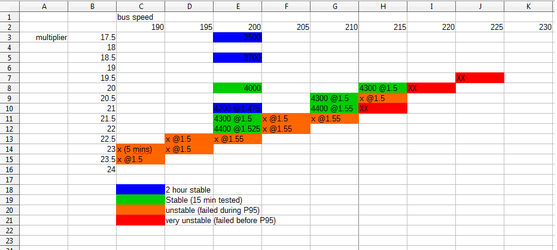
The inside of my case. (I am fully aware that my cable management is atrociously bad)
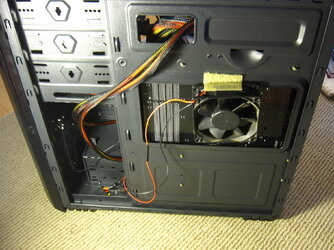
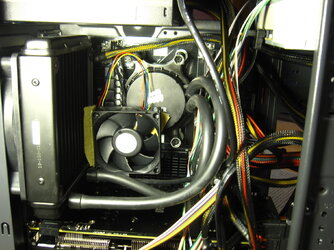
My best stress-tests so far:
